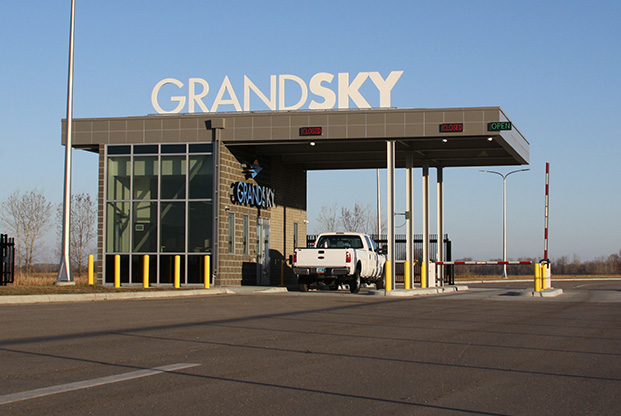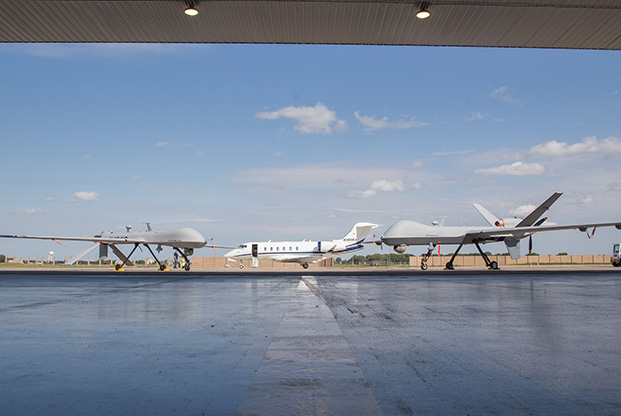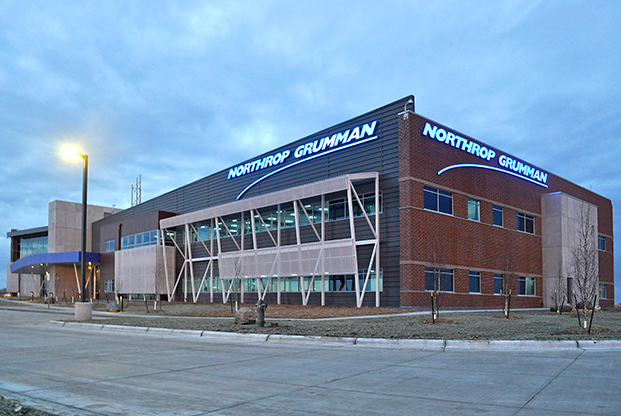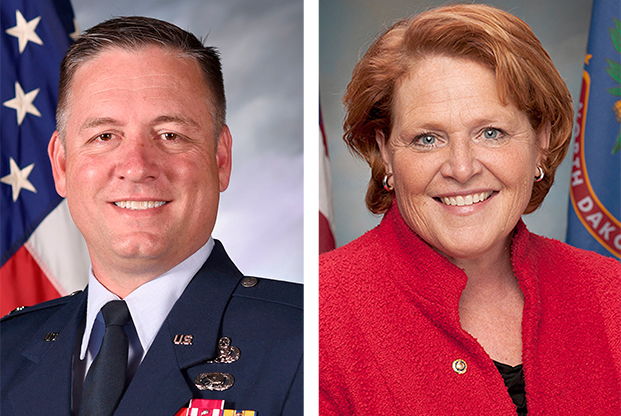
Grand Sky’s Gatehouse opens up to a 217-acre facility and provides secure access for tenants. Photo: Grand Sky Development Co.
Although there is general agreement that the US military has far more bases than it actually needs—by a recent Pentagon count, the Air Force has 22 percent excess base capacity—for more than a decade Congress has refused to even consider closing any more defense facilities. The Air Force says it wastes billions in overhead costs by not consolidating at fewer locations.
Members of Congress fear a loss of jobs, economic activity, and property values in their districts, and have compelled the services to keep open installations that just don’t have enough people, equipment, or missions to make them militarily effective.
Grand Forks, N.D., has proved this fear doesn’t have to come true. Its commercial aircraft center, which makes use of former Air Force facilities in partnership with the service, has been hailed by many as a model for the base of the future.
The concept was born after the 2005 iteration of the Base Realignment and Closure (BRAC) process. Under BRAC, the Pentagon submits a list of realignments and closures to Congress, which can either vote the whole package up or down—without tweaking—thus providing members with political cover. Many communities have put together local task forces looking for ways to make their bases “BRAC-proof.”
In the 2005 BRAC, Grand Forks Air Force Base lost a tanker mission. The base didn’t close, but there was a large reduction in the number of airmen stationed there. This delivered a hit to the economy of Grand Forks County, with a population of about 100,000 people, county government relations manager Tom Ford explained.
That’s when local officials got together and asked, “What can we do to offset that negative impact, and how do we make our community less dependent on the base if we were to ever lose the base?” Ford said.

General Atomics, an anchor tenant at Grand Sky, displays an MQ-1 and an MQ-9 outside its Flight Test and Training Center. Photo: General Atomics Aeronautical Systems Inc.
Around the same time, the RQ-4 Global Hawk intelligence, surveillance, and reconnaissance mission came to Grand Forks Air Force Base, which is also home to the John D. Odegard School of Aerospace Sciences. The local team thought that coming up with a plan to support the emerging drone business might be a good idea for Grand Forks, Ford said.
The thinking was, “what if we use some of the excess capacity on base, since we lost tankers, to make a flight center?” for unmanned aerial systems (UAS), he explained.
The county hired Jeff Donohoe as a consultant. Donohoe brought on Tom Swoyer, who now leads the development of Grand Sky, a business park and flight center for commercial unmanned aerial systems on 217 acres of Air Force land. A feasibility study showed an enhanced-use lease (EUL) could work, and a deal was signed in 2015, Swoyer said.
The Air Force has used EULs at other bases, but few have been as successful as Grand Forks in developing synergies with an Air Force mission while spurring industry, education, and economic development in the local community. The anchor tenants at Grand Sky are Northrop Grumman and General Atomics. Both hold various military contracts, but their work at Grand Sky is focused on commercial UAS development. They use a separate security entrance from the base, but can launch and recover aircraft from the base’s runway. There’s schedule availability that’s attractive to tenants and compatible with the base’s Global Hawk mission.
Like many northern-tier bases, Grand Forks is cold in the winter and can be quite windy, but Swoyer said it averages 320 flying days annually. The private entities can also use Air Force radar, under a new agreement, and have their own dedicated access to the feed, which allows them to eliminate use of chase planes. These are ways the Air Force brings value to the partnership by creating training opportunities and reduced costs, Swoyer said.
Since the EUL was signed in 2015, Grand Sky has expanded quickly, but there’s plenty of room for growth. Only about 20 acres are under contract out of the 217 acres available.
“We offer schedule certainty and the ability to use an Air Force runway. We provide a lot of value to companies that are in the DOD space,” Swoyer said.He said the organization touts Grand Forks as the “base of the future. There’s a lot of value-added in terms of employment, engagement, and the raw exchange of support to each other.”

Northrop Grumman, also an anchor tenant at Grand Sky, offers the first commercial UAS flight testing range in the US. Photo: Grand Sky Development Co.
While economic development was a desired by-product of the effort, the initial focus was how can the community and the base forge a tighter bond, Swoyer said. The relationship between the base and the community was always good, but has strengthened in recent years because both sides are really getting something from it, he said.
“They’re the epicenter of commercial UAS,” Swoyer said. “This is the only place where you can set up shop and start flying and working. Right now, the UAS focus is small unmanned aircraft, but the clear migration is toward larger, more capable aircraft like the military uses. It’s happening, so we’re positioning ourselves to support that activity.”
Grand Forks is a unique case, but the key players agree that there are lessons to be learned from it that can be applied in other Air Force communities.“It always works better when there’s an idea,” Swoyer said. “You can’t really just put a piece of land out there and say ‘oh, come develop this for us.’ There has to be a reason to develop it.”
Retired Lt. Gen. William J. Rew was the vice commander at Air Combat Command from 2009 to 2013 and got involved in the Grand Forks team around that time. Grand Forks had been an Air Force Materiel Command base until it transferred to ACC this year.
Rew grew up as the son of a bomber airman on old Strategic Air Command bases, many now closed. He said the northern-tier bases such as Grand Forks need to be looked at now from a strategic perspective, considering the global interest in the Arctic region.
“If we look at the Arctic, wouldn’t it be nice to have Active Duty bases that we can do missions from, being closer to the challenge, closer to the threat?” Rew said. “That has always been beneficial. How do we look at these northern-tier bases … differently than we have in the past?” The base now has a leading role in unmanned systems, and in pioneer programs creating associations with “the National Guard, Customs and Border Protection, UND [the University of North Dakota], and now Grand Sky.” Although “it does get cold in the winter,” the low-population region offers “unique opportunities” in available airspace. “When you put that all together, it makes a very compelling case for retaining a base like Grand Forks in the future and keeping our strategic options open,” he asserted.
Terry A. Yonkers was the assistant secretary of the Air Force for installations, environment, and logistics when the Grand Forks EUL was being developed.“Grand Forks is really turning into a model—if not the model—for the enhanced-use lease approach,” he said. “What’s unique about Grand Forks is the EUL is oriented toward the mission.”
A number of enhanced-use leases have been used over the last decade, but aren’t militarily connected, leading to businesses such as hotels, strip malls, or other retail space.
Grand Forks was the model for an EUL that was recently approved at Kirtland AFB, N.M., where about 107 acres of nonexcess property on the base perimeter was made available. Thunderbird Kirtland Development Ltd., Co. proposed a research park with office, industrial, laboratory, retail, and hospitality facilities targeting Defense Department business and contractors wanting to relocate operations close to DOD, Air Force, and other federal partners.
“The research park will revitalize the area while remaining compatible with the missions, plans, and programs at Kirtland,” according to a USAF press release. “The close proximity of public and private sector partners is expected to increase communications and potentially compress research and development life-cycle times,” it said.
During his first visit to Grand Forks, Yonkers said, civic leaders said they were nervous about being on the BRAC candidate list again and wanted to see if there was anything they could do to secure the base’s future in their community.
One of the ideas that came out of the trip was the EUL and in Grand Forks, local leaders ran with it.
“These things are not easy, or everybody would be doing them,” Yonkers observed. “There probably is opportunity on almost every installation. I do think there’s mission synergy to be had at almost every installation.”
Some of the key elements, Yonkers said, are retail and an element of financial return, since developers won’t be able to generate enough revenue to sustain the lease without it.
_
You can read this story in our print issue:
Grand Sky was fortunate to get to major tenant anchors early on, so they haven’t needed to rely on retail, but many others have needed retail to make the finances work, Yonkers noted.
Mission synergy is beneficial for the Air Force when it can be found, he said, but it’s also beneficial in generating revenue from property that is otherwise not being used.
Leases like Grand Forks can generate $2 million to $3 million worth of value for the Air Force. If similar scenarios play out at other bases nationwide, that could generate billions for the service, relieving strain on its budget.Collectively, “That’s not inconsequential,” he pointed out.
Wing commanders keep about 50 percent of the lease revenue for base initiatives. At Grand Forks, the base was able to reopen the bowling alley and improve its theater. The first movie shown was “Star Wars.”
“In a place like Grand Forks, it’s particularly a benefit to quality of life and airmen morale because they’re so far out in the country,” Yonkers said.
The prospect of extra revenue also encourages wing commanders to take an active role in finding possibilities for EULs with the local community, he said, though the Air Force can realistically only handle four or five EULs at a time.“These things are not easy and they’re time consuming,” Yonkers asserted, but “they’re good all the way around. Grand Forks is at the top of the heap in terms of community partnerships and the EUL is part of that. I think there’s a tremendous amount of benefit for everybody … involved.”
In Grand Forks, the community initially wanted to support the Distributed Common Ground System, but recognized the military’s shift toward remotely piloted systems.
“This is the future of military aviation. If you want to make your Air Force base relevant, let’s invest in that,” was the community’s thinking, Swoyer said.Grand Forks County holds the 50-year lease with the Air Force and Ford said they bid the lease like any other county project. Grand Sky won the bid, which signed a sublease with the county, putting all of the Air Force’s requirements on Grand Sky.
The county remains responsible for making payments—handled through an escrow account—ensuring compliance with the lease and submitting documents and reports.
“As for the fiscal impacts, the project is still in its infancy, so it hasn’t reached its full potential yet, but … the impact on the community has been huge,” Ford said. “It brought a wave of excitement to the community and state, as well as a national spotlight to the community. Grand Forks and North Dakota has become the center for all things UAS.”

Col. Benjamin Spencer, commander of the 319th Air Base Wing, says the partnership is a win for the Air Force and Sen. Heidi Heitcamp (D-N.D.) helped organize the perfect storm of UAS synergies that led to Grand Sky. Photos: USAF; Office of Sen. Heidi Heitcamp
North Dakota investment in unmanned aerial systems goes back to 2007, Swoyer said, when then-governor (now senator) John Hoeven supported efforts for the state to get one of the UAS test sites approved by the Federal Aviation Administration.
The state won the Northern Plains UAS Test Site. Executive Director Nick Flom said one of the goals is to create jobs within the state. “If they’re going to do testing, wouldn’t it be great if they stayed and set up shop here?” Flom asked.
The test site supports commercial UAS efforts and Flom noted the open airspace offered at Grand Sky is appealing to the industry.
“It’s a layered approach,” he said. “There’s a lot of people bringing different specialties and levels of support to this.”
North Dakota’s Sen. Heidi Heitkamp (D) helped set the stage for the perfect storm of UAS synergies that led to the Grand Sky lease.
“The agreement will allow the Air Force and private sector to collaborate on critical research and training that will support 21st century Air Force missions,” said Heitkamp. “Public-private partnerships like the one in Grand Forks set an example for the rest of the nation of how infrastructure can be leveraged for the mutual benefit of the Air Force, defense communities, and private industry. Grand Forks’ growing expertise in remotely piloted aircraft will generate a new kind of air base in Grand Forks … one that’s vital for the long-term future of the Air Force.”
Grand Forks Air Force Base commander Col. Benjamin Spencer said that in addition to the financial benefit to the base from the rent payment, the EUL challenges the Air Force to be creative and to innovate.
“With a shared flight line and airspace and our air traffic controllers providing airfield management, Grand Sky operations consistently drive us to find better ways to do business, in some cases crafting pioneering processes. At the end of the day, if the innovation being generated at Grand Sky finds its way into products and services that enhance Air Force combat capability, then the EUL is a win for the Air Force at-large as well. Bottom line … the EUL makes us better,” said Spencer. All of those involved at Grand Forks said there are lessons other communities can learn from their success and apply to their own EUL efforts.
“Communities can look at what their base does and then figure out what they can do to support that mission. This isn’t pure real estate, it’s about mission effectiveness and mission synergy,” Swoyer said.
Most communities hosting a base probably worry about whether it will always be there, adding to the local prosperity, he said.
“There’s no foolproof strategy that would keep a base from closing and this certainly is not one,” he observed, but the Grand Sky arrangement “is an investment in an industry that has commercial viability” for which there is a proven market. “The goal is not specifically to BRAC-proof, the goal is to improve efficiency.”
_Jenn Rowell is a military-local government reporter based in Great Falls, Mont.